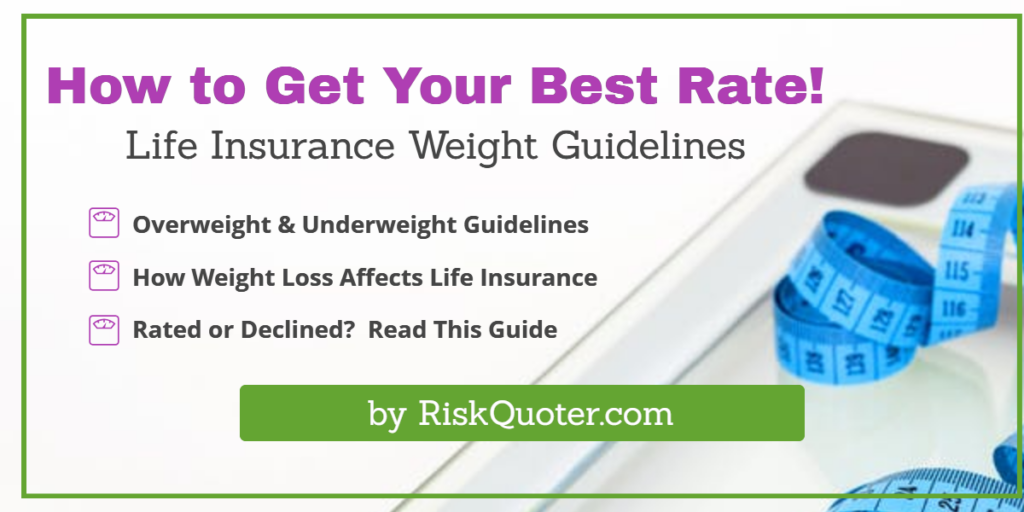You’re not alone if you’re concerned about how your weight affects your life insurance rates.
Many wonder whether a few extra pounds (or more) will impact their ability to get affordable life insurance. The good news? You have options.
This guide will help you understand how life insurance companies evaluate your height and weight, how BMI factors into underwriting, and which companies are the most lenient about building charts.
How Life Insurance Companies Use Height & Weight Charts
Life insurance companies categorize applicants into rate classes based on their weight. While guidelines vary by insurer, here’s what you need to know:
- Preferred Best – The strictest category, with little to no wiggle room on weight limits.
- Standard Rates – More lenient, especially if you have no other health concerns.
- Table Ratings – If your weight exceeds the standard cut-off, insurers assign a table rating, which can increase premiums by 25% per table.
- Age Adjustments – Some insurers allow higher weight limits for applicants over age 60.
Many insurers now publish both build charts and BMI charts. Some companies even take a more flexible, case-by-case approach.
Common Build Chart Types Used by Insurance Companies
| Company | Type of Build Chart |
|---|---|
| Banner Life | Unisex |
| Brighthouse | Male and Female Build Charts |
| Cincinnati Life | Male and Female Build Charts Unisex Charts for “standard” rates |
| Corebridge Financial | Unisex BMI Charts |
| Lincoln Financial | Unisex for ages 18-60 and 61+ |
| Minnesota Life | Unisex for ages 16-64, 65-74 and 75+ |
| Mutual of Omaha | Unisex |
| Nationwide | Unisex – Separate charts for whole life and juveniles. |
| North American | Unisex for ages 16-70 and 71+ |
| Pacific Life | Unisex for ages 18-64 and 65+ |
| Penn Mutual | Unisex |
| Principal | Unisex for 20-44, 45-64 and 65+ |
| Protective Life | Unisex for ages 18-70 and 71+ |
| Prudential | Unisex for ages 18-59 and 60+ |
| Sagicor | Unisex Build Charts |
| SBLI | Unisex Build Charts |
| Security Mutual | Unisex Build Charts |
| Symetra | Male and Female Build charts for term life, unisex for universal life. |
| Transamerica | Male and Female Build Charts for ages 18-70 and 71+ |
| Zurich | Male and Female Build Charts for ages 18-70 and 70+ |
Don’t worry about memorizing these – We’ll match you with the best company for your weight!
How to Calculate Your BMI for Life Insurance
While not all companies rely on BMI, many use it in decision-making. Here’s how to calculate yours:
BMI Formula
- Take your weight in pounds (ex: 220 pounds)
- Measure your height in inches (ex: 6 feet tall is 72 inches)
- Square your height: 72 x 72 = 5184
- Multiply by 703 (conversion factor to metric units)
- Divide: (220 / 5184) x 703 = 29.83 BMI.
A BMI of 30 or higher is typically considered obese, while a BMI under 18.5 may trigger underweight underwriting concerns.
Tips to Improve Your Life Insurance Approval Odds
Before Your Paramedical Exam:
- Schedule Morning Appointments Only – You weigh less first thing in the morning.
- Wear Light Clothing – If you are close to the weight limits.
- Avoid Salty Foods and Heavy Meals – It may raise blood pressure and weight.
- Stay Hydrated – It makes it easier for the examiner to get a blood sample and urine sample.
Life Insurance for Overweight & Underweight Applicants
If you’ve been rated or denied life insurance due to weight, here’s what to do.
If weight was the only issue, we may be able to move to a new company that is more lenient with underwriting. If you have other health concerns, we’ll also address those issues.
If you received a table-rated offer, we may be able to eliminate or reduce table ratings.
Insurers with higher weight limits include:
- Pacific Life
- Prudential
- John Hancock
- Corebridge Financial
If you’ve lost or gained weight recently, many insurers will average your weight over the past year to prevent applicants from crash dieting before their paramed.
Life Insurance & Weight Loss Medications (Ozempic, Wegovy, etc.)
If you are taking Ozempic, Wegovy, or another similar medication for weight loss, here’s what you need to know:
- If the medication is strictly for weight loss, underwriting follows build guidelines.
- Was the medication prescribed for diabetes? Underwriting follows diabetes guidelines.
- Your weight is averaged if you started the medication within the past 12 months.
- If more than 12 months, your current weight is used.
Get the Best Life Insurance Rate for Your Weight
The most important factor is choosing the right insurance company based on height and weight. Every company evaluates weight differently, so having an experienced agent on your side makes a huge difference.
What We Do For You
- Compare insurers to find the best match for your build.
- Provide underwriting tips to improve your rate class.
- Help you avoid costly mistakes when applying.
There’s never any pressure or obligation. If you’re ready to explore your options, take two minutes to request a free quote today!

